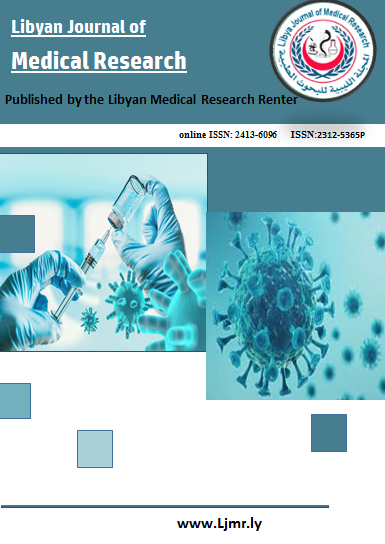Assessment Of Milk Fat Content And Certain Heavy Metals In Various Cheese Types ( W. Libya).
DOI:
https://doi.org/10.54361/LJMR.19.1.06Keywords:
Milkfat, solid materials, , Heavy metals, CheesesAbstract
Purpose:The objective of this study was to determine some of heavy metals ( Pb & Cd ), milk fat and solid materials in dry weight percentage with digestion in cheeses which comparing with Libyan standards.
Method: This study was conducted in Center for Food and Drug Control in Tripoli Branch by used five different samples from local and imported of processed cheeses which called (Alwald aldhaki, Alrebeyh, Al-Moutamaiez, Al-Moutafawek and Daily ). The samples were collected from the markets of Sabratha city in western Libya.
Results: Moreover, results showed that the milk fat and solid materials in dry weight were (39.9 & 55.1%, 41.5 & 60.3%, 40.8 & 53.9%, 53.3 & 50.6% and 43.6 & 50.4%) as order respectively, this mean that were conforming to standard specifications. According to that results, amounts of heavy-metal in dairy products are considered not to be of great concern to public health.
Conclusion: The study recommended encouraging dairy industry in Libya to consume these types of cheeses, through strict control for food transportation and stores.
Downloads
References
- Fox PF, McSweeney PLH, Cogan TM, Guinee TP. Cheese: Chemistry, Physics and Microbiology. Third. Cork, Ireland; 2004.
- Anguebes-Franseschi F, Abatal M, Ucán CA, Ruiz Marín A, et al. Determination of the Concentration of Heavy Metals in Artisanal Cheeses Produced in the Mexican States of Tabasco and Chiapas. Molecules. 2023;28(23).
- Olson N. Types of Cheese. Elsevier Science Ltd. 2003;
- Enab A, Hassan FA. EFFECT OF MANUFACTURE STEPS ON CHEESE STRUCTURE (REVIEW). INTERNATIONAL JOURNAL of ACADEMIC RESEARCH. 2012;79–89.
- Martín, M. I. G., Quintana, A. M. V., Revilla, I. & Esteban, J. S. The determination of fatty acids in cheeses of variable composition (cow, ewe's, and goat) by means of near infrared spectroscopy. Microchemical Journal. 2020; 156(104854).
- Guinee, T. P. Cheese Pasteurized Processed Cheese Products. Elsevier B.V. 2016;pp. 805-813.
- Christophoridis CE. Determination of heavy metals and health risk assessment of cheese products consumed in Greece. Journal of Food Composition and Analysis. 2019;82.
- Anastasio A. Heavy Metal Concentrations in Dairy Products from Sheep Milk Collected in Two Regions of Southern Italy. Acta Vet Scand. 2006;47(1):69–74.
- Stanovič, R. et al. DETERMINATION OF HEAVY METALS CONCENTRATION IN RAW SHEEP. Potravinarstvo® Scientific Journal for Food Industry. 2016; 95-99.
- Baseri E. Determination of Heavy Metals through Inductively Coupled Plasma-Optical Emission Spectrometry (ICP-OES) in Iranian Cheese and Their Potential. Iranian Journal of Health, Safety & Environment. 2017;l.5:926–933.
- KLEYN, D. H. et al. Determination of Fat in Raw and Processed Milk by the Gerber. KLEYN ET AL.: JOURNAL OF AOAC INTERNATIONAL. 2001;84: 1499 - 1508.
- M., K. H. & F., S. A. Determination of Heavy Metals (Pb, Cd) and some Trace Elements in Milk and Milk Products Collected from Najran Region in K.S.A. Life Science Journal, 2013;10 (2):648 - 652.
- ALTUN SK, AYDEMİR ME. Determination of some minerals and heavy metal levels in Urfa cheese and cow’s milk. Food and Health. 2021;7:185–193.
Downloads
Published
Issue
Section
License
Copyright (c) 2025 Aiman Mustafa Abulgasim , Elmoktar Hasan Elbakosh (Author)

This work is licensed under a Creative Commons Attribution-NonCommercial-NoDerivatives 4.0 International License.
Open Access Policy
Libyan journal of medical Research (LJMR).is an open journal, therefore there are no fees required for downloading any publication from the journal website by authors, readers, and institution.
The journal applies the license of CC BY (a Creative Commons Attribution 4.0 International license). This license allows authors to keep ownership f the copyright of their papers. But this license permits any user to download , print out, extract, reuse, archive, and distribute the article, so long as appropriate credit is given to the authors and the source of the work.
The license ensures that the article will be available as widely as possible and that the article can be included in any scientific archive.
Editorial Policy
The publication of an article in a peer reviewed journal is an essential model for Libyan journal of medical Research (LJMR). It is necessary to agree upon standards of expected ethical behavior for all parties involved in the act of publishing: the author, the journal editorial, the peer reviewer and the publisher.
Any manuscript or substantial parts of it, submitted to the journal must not be under consideration by any other journal. In general, the manuscript should not have already been published in any journal or other citable form, although it may have been deposited on a preprint server. Authors are required to ensure that no material submitted as part of a manuscript infringes existing copyrights, or the rights of a third party.
Authorship Policy
The manuscript authorship should be limited to those who have made a significant contribution and intellectual input to the research submitted to the journal, including design, performance, interpretation of the reported study, and writing the manuscript. All those who have made significant contributions should be listed as co-authors.
Others who have participated in certain substantive aspects of the manuscript but without intellectual input should only be recognized in the acknowledgements section of the manuscript. Also, one of the authors should be selected as the corresponding author to communicate with the journal and approve the final version of the manuscript for publication in the LJMR.
Peer-review Policy
- All the manuscripts submitted to LJMR will be subjected to the double-blinded peer-review process;
- The manuscript will be reviewed by two suitable experts in the respective subject area.
- Reports of all the reviewers will be considered while deciding on acceptance/revision or rejection of a manuscript.
- Editor-In-Chief will make the final decision, based on the reviewer’s comments.
- Editor-In-Chief can ask one or more advisory board members for their suggestions upon a manuscript, before making the final decision.
- Associate editor and review editors provide administrative support to maintain the integrity of the peer-review process.
- In case, authors challenge the editor’s negative decision with suitable arguments, the manuscript can be sent to one more reviewer and the final decision will be made based upon his recommendations.














